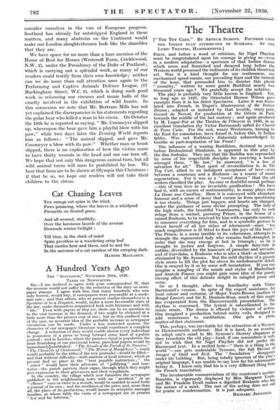The Theatre
[" THE TOY CART." BY ARTHUR SYMONS. FOUNDED UPON THE INDIAN PLAY ATTRIBUTED TO SUDRAKA. AT THE LYRIC THEATRE, HAMMERSMITH.] FIRST, and before a word of criticism, Sir Nigel Playfair must be congratulated upon his courage in giving us—even in a modern adaptation—a specimen of that Indian drama which arose and flourished and decayed long before the Western world possessed the rudiments of its childish theatrical art. Was it a kind thought for our restlessness, our mechanized speed-mania, our prevailing fears and the turmoil of the hour, that persuaded him to disinter this placid " morality," written by some gentle Buddhist nearly two thousand years ago l We gratefully accept the sedative. The play is probably very little known in England. Yet, so long ago as 1827, the Orientalist Horace Wilson gave excerpts from it in his Select Specimens. Later it was trans- lated into French, in Dupre's Masterpieces of the Indian Drama ; adapted or imitated by that lovable, crazy poet, Gerard de Nerval, for production at the Odeon in Paris towards the middle of the last century ; and again. produced by M. Lugne-Poe at the Theatre de l'Oeuvre in 1895, in an excellent translation.(by Victor Barrucand) called Le Chariot de Terre Cuite. For the rest, weary' Westerners, turning to the East for consolation, have found it, before this, in Indian fables. Was not Kalidasa's Sakuntala acknowledged by Goethe as part-inspiration of his Faust The influence of a waning Buddhism, destined to perish before Brahminical Hinduism, is apparent in this play by the dim Sudraka. They say that the Buddha was reproached by some of his respectable disciples for receiving a bandit amongst them. " My law," he answered, is a law of salvation for all." That spirit of reconciliation is, in The Toy Cart, allied to an indulgent acceptance of love—even between a courtesan and a Brahmin—as a source of moral regeneration. For it was as a "moral drama" that the old writers classified the play. An easy or doubtful moral, perhaps —this of true love as an invariable purification ! We have had it, with an excess of sentimentality, in many plays since La Dame aux Candlias. Here it is conveyed with abundant humour and a sense of irony that excuse us from questioning it too closely. Things just happen, and hearts are changed, under the guidance of some divine prompting. The lady of the high roads, the beautiful Vasantasena, has only to seek refuge from a wicked, pursuing Prince, in the house of a ruined Brahmin, to be received by him with exquisite courtesy, to renounce everything for him, and in a symbolic gesture to divest herself of all her riches of adornment—since " too much magnificence is ill fitted to feast the joys of the heart." The Prince, in a scene terrible in its vehemence, attempts to strangle the regenerated lady who remains half-strangled, in order that she may emerge at last in triumph ; as he is brought to justice and forgiven. A simple fairy-tale in outline, diversified by the humours of parasites and servants, and of Carvilaka, a Brahmin who is also a thief—a character eliminated by Mr. Symons. But the mild rhythm of a gnomic style seems to lift the plot far above its Melodramatic detail. One is swayed by it as by some soft incantation. If you can imagine a mingling of the minds and styles of Maeterlinck and Anatole France you might gain some idea of the purely literary effect of this delicate delight in mingled prose and verse.
Or so I thought, after long familiarity with Victor Barrucand's version. In spite of the eXpert assistance, for local colour and costume, of Major Yeats-Brown (author of
Bengal Lancer) and Sir, E. Denison-Ross, much of this magic has evaporated from the Hammersmith presentation. The rhythm is coarsened. The lyrical is subordinated to the comic strain. The dream is effaced by violence of action. One imagined a production behind misty veils, designed to add remoteness to meditation. One gets a plain, matter-of-fact statement.
This, perhaps, was inevitable for the attraction of a Western or Hammersmith audience. But it is harth in an evening,
to adapt one's mind to Mr. Symons's, literary elegances as
they transform, the old play—hard, if one remembers it well, not to wish that Sir Nigel Playfair did not prefer the
Barrucand text. In a recited lyric—"there is a thing in the
world "—one gets undeniable Symons, the full flavour of Images of Good and Evil. The foundation " disappears under his building. But, being totally ignorant of the Play, original language, I am unable to say how far his adornments betray it. I know only that his is a very different thing from the French translation. The invulnerable cOnmiereialism of the courtesan's mottle:, Rambha, is vigorously displayed by Miss Margaret Yards' and Mr. Franklin Dyall makes a dignified Brahmin who hail the nature of a saint. The rest of the acting does not ea for praise or. condemnation. It is just adequate. • RICHARD JENNEgGS.


















































































 Previous page
Previous page